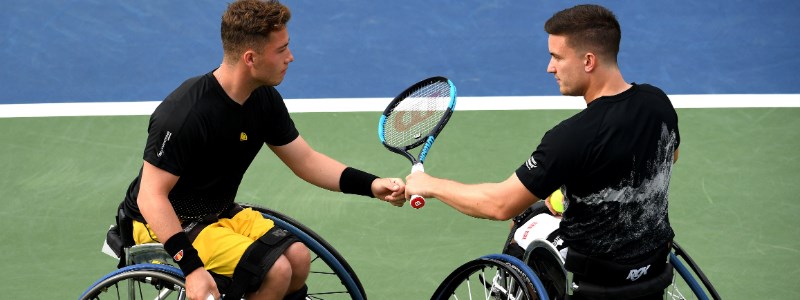
Wheelchair Tennis classification: everything you need to know
• 4 MINUTE READ
Wheelchair tennis differs from the traditional form of the sport in only two respects. The first is the well-known ‘two bounce rule’, which means a player can let the ball bounce twice before returning it (although only the first bounce needs to be in the court of play). The second, and perhaps less understood difference, is the classification system that determines which competition a player takes part in.
Here we explain everything you need to know about classification ahead on cheering on the British players in Paris next week!
What are the different classification divisions in wheelchair tennis?
When Brits Alfie Hewett, Gordon Reid, Jordanne Whiley and Andy Lapthorne take to the courts at Roland Garros this week, the quartet of recent US Open doubles champions will again compete for Grand Slam titles across six wheelchair draws – men’s singles and doubles, women’s singles and doubles and quad singles and doubles.
Like all para sports, wheelchair tennis has an international classification system designed to ensure that as far as possible, competition is fair and is determined by sporting ability rather than by a player’s degree of impairment.
Classification for wheelchair tennis is undertaken by the International Tennis Federation (ITF), which operates two competition categories (sport classes) - the Open Division and the Quad Division.
Wheelchair tennis first featured at a Grand Slam in 2002 when men’s and women’s singles competition were introduced at the Australian Open. Inclusion of the sport has continued to progress since then, and all four Grand Slam tournaments now feature men’s, women’s and quad singles and doubles draws after Roland Garros and Wimbledon introduced quad singles and doubles events for the first time in 2019.
Who can compete in the Open Division?
Under the ITF Wheelchair Tennis Classification System, players are eligible to compete in the Open division if they have a permanent physical disability that results in substantial loss of function in one or both lower extremities (limbs) and that meets or exceeds the sport’s eligibility criteria.
Male and female players in the Open division compete in separate draws – hence ITF tournaments consist of men’s and women’s singles and doubles draws and there are separate men’s and women’s singles and doubles world rankings.
Great Britain’s leading players in the Women’s section of the Open Division include Jordanne Whiley and Lucy Shuker, currently ranked world No.5 and 12 respectively, with the pair winning Paralympic medals in the doubles in both London and Rio. The Men’s section is headed by world No.3 Alfie Hewett and world No.5 Gordon Reid. The latter is the reigning Paralympic champion, having defeated Hewett in the final at Rio 2016, and the duo combine to form one of the leading doubles pairings in the sport.

What about the Quad Division?
Players who meet the criteria of the Open division but also have a permanent physical disability that results in substantial loss of function in one or both upper extremities, and where at least three extremities are affected, are eligible to compete in the Quad division.
Depending on the level of quad division player’s loss of function, they may tape the racket to their hand.
The Quad division is classified based on disability rather than gender, and so male and female players compete together in one singles and/or doubles draw. There is therefore just one quad singles world ranking and one quad doubles world ranking, which feature both male and female players.
Britain’s leading player in the Quad division is London’s Andy Lapthorne, the current world No.2 and 12-time Grand Slam champion. It is also the Quad Division where Great Britain first achieved international success in wheelchair tennis – the legendary Peter Norfolk, affectionately nicknamed ‘The Quadfather’, became the country’s first Paralympic wheelchair tennis gold medallist in Athens in 2004, before going on to win multiple Grand Slam titles.
Back the Brits at the French Open
Keep up-to-date with all the latest news by following LTA on Twitter, Facebook and Instagram, and signing up to LTA's free newsletter.





